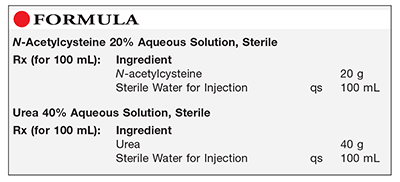US Pharm. 2016;41(8):34-35.

Method of Preparation—N-Acetylcysteine 20% Aqueous Solution, Sterile: Note—This formulation should be prepared according to strict aseptic compounding technique in a laminar airflow hood in a cleanroom or via isolation-barrier technology by a compounding pharmacist who is validated in aseptic compounding. This is a high-risk preparation.
Calculate the required quantity of each ingredient for the total amount to be prepared. Accurately weigh or measure each ingredient. Dissolve the N-acetylcysteine in sufficient Sterile Water for Injection to final volume and mix well. Sterile-filter into appropriate sterile containers. Package and label.
Method of Preparation—Urea 40% Aqueous Solution, Sterile: Note—This formulation should be prepared according to strict aseptic compounding technique in a laminar airflow hood in a cleanroom or via isolation-barrier technology by a compounding pharmacist who is validated in aseptic compounding. This is a high-risk preparation.
Calculate the required quantity of each ingredient for the total amount to be prepared. Accurately weigh or measure each ingredient. Dissolve the urea in sufficient Sterile Water for Injection to final volume and mix well. Sterile-filter into appropriate sterile containers. Package and label.
Use: These preparations have been used to reduce mucus accumulation after urinary diversion procedures.
Packaging: Package in sterile containers.
Labeling: For professional use only. For instillation. Not for injection.
Stability: Check the current edition of the U.S. Pharmacopeia for the appropriate beyond-use date for this compounded preparation.1
Quality Control: Quality-control assessment may include weight/volume, physical observation, pH, specific gravity, osmolality, assay, color, clarity, particulate matter, and sterility.2,3
Discussion: During a pelvic exenteration or cystectomy, a urinary diversion may be performed via surgical construction. Traditionally, this involves the reconnection of the ureter to a transposed portion of the bowel, creating a new urinary pouch. However, this leads to incontinence because of constant drainage of the pouch through a stoma into a urostomy appliance. The bowel mucosa can still produce as much as 35 g of mucus daily. The resulting increase in urinary viscosity may lead to complications including obstruction, infection, and stone formation.
Therapies to reduce mucus production, urine production, or both include oral ranitidine and oral aspirin. Urine-pouch instillations of a urea or N-acetylcysteine solution and a subcutaneous injection of octreotide have also been used.4
N-acetylcysteine (Mucomyst, C5H9NO3S, MW 163.19) is a mucolytic agent. It occurs as a white, crystalline powder with a slight acetic odor that is freely soluble in water (1 g in 5 mL) and in alcohol (1 g in 4 mL).1 The sulfhydryl group in the molecule opens the disulfide bonds in mucus and lowers the viscosity. This mucolytic activity is pH-related, occurring significantly between pH 6 and 9.5
Urea (carbamide, ureum, carbonic acid diamide, NH2CONH2, MW 60.06) occurs as colorless, transparent, slightly hygroscopic, odorless or almost odorless, prismatic crystals or as a white, crystalline powder or pellets. Upon prolonged standing, it may develop a slight odor of ammonia. Urea is highly soluble in water, soluble 1 g in 10 to 12 mL of alcohol, and soluble 1 g in 1 mL of boiling alcohol. Its solutions in water are neutral to litmus. 6
Sterile Water for Injection is water for injection that has been sterilized and suitably packaged; it contains no added substances. It is a clear, colorless, odorless, and tasteless liquid. Purified water is water that is obtained by distillation, ion exchange, reverse osmosis, or some other suitable process. Water has a specific gravity of 0.9971 at room temperature, a melting point of 0°C, and a boiling point of 100°C. It is miscible with most polar solvents and is chemically stable in all physical states (ice, liquid, and steam).7
REFERENCES
1. U.S. Pharmacopeia/National Formulary [current revision]. Rockville, MD: U.S. Pharmacopeial Convention, Inc; July 2016.
2. Allen LV Jr. Standard operating procedure for particulate testing for sterile products. IJPC. 1998;2:78.
3. Allen LV Jr. Standard operating procedure: quality assessment for injectable solutions. IJPC. 1999;3:406-407.
4. Covert WM, Westin SN, Soliman PT, Langley GD. The role of mucoregulatory agents after continence-preserving urinary diversion surgery. Am J Health Syst Pharm. 2012;69:483-486.
5. Allen LV Jr, ed. Remington: The Science and Practice of Pharmacy. 22nd ed. London, England: Pharmaceutical Press; 2013:1200-1201.
6. Reynolds JE, ed. Martindale: The Extra Pharmacopoeia. 30th ed. London, England: Pharmaceutical Press; 1993:831.
7. Dubash D, Shah U. Water. In: Rowe RC, Sheskey PJ, Cook WG, Fenton ME, eds. Handbook of Pharmaceutical Excipients. 7th ed. London, England: Pharmaceutical Press; 2012:880-884.
To comment on this article, contact rdavidson@uspharmacist.com.





